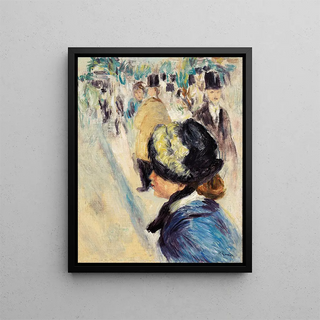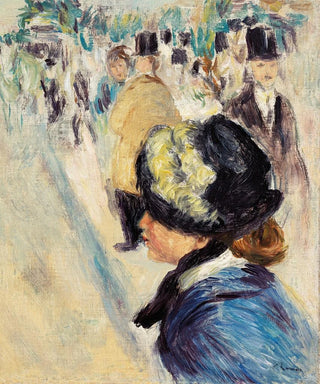Art print | La place Pigalle étude - Pierre-Auguste Renoir


View from behind

Frame (optional)
La place Pigalle, iconic Parisian crossroads, has been immortalized by Pierre-Auguste Renoir in a vibrant study that captures the very essence of urban life at the end of the 19th century. This painting, a true window into a world in motion, immerses us in the lively atmosphere of Montmartre, where artists, strollers, and city lovers mingle. Through this artwork, Renoir does not merely reproduce a scene; he elevates its details, colors, and lights, offering the viewer an immersive experience that transcends simple observation. The art print La place Pigalle étude - Pierre-Auguste Renoir allows us to rediscover this masterful work while connecting to the artistic heritage of its creator.
Style and uniqueness of the work
Renoir's style is inseparable from his ability to capture light and movement. In La place Pigalle étude, he employs a palette of vivid colors, where warm tones blend with cooler shades, creating a harmonious balance. The brushstrokes, both fluid and dynamic, bring each character and shadow cast by the Parisian sun to life. The work stands out for its impressionist approach, where the artist favors sensory perception over realistic representation. Details are suggested rather than rendered precisely, enabling the viewer to interpret the scene in their own way. This painting style, which invites emotion rather than analysis, makes La place Pigalle étude an emblematic example of impressionist art, while revealing Renoir's unique ability to capture the spirit of his time.
The artist and his influence
Pierre-Auguste Renoir, a prominent figure of the impressionist movement, left his mark on his era through his innovative approach to painting. Born in 1841, he evolved within a vibrant artistic context where academic conventions were being challenged. Renoir was influenced by masters such as Monet and Degas, but he also developed a distinctive style focused on humanity and the beauty of everyday scenes. Through his works, he

Matte finish

View from behind

Frame (optional)
La place Pigalle, iconic Parisian crossroads, has been immortalized by Pierre-Auguste Renoir in a vibrant study that captures the very essence of urban life at the end of the 19th century. This painting, a true window into a world in motion, immerses us in the lively atmosphere of Montmartre, where artists, strollers, and city lovers mingle. Through this artwork, Renoir does not merely reproduce a scene; he elevates its details, colors, and lights, offering the viewer an immersive experience that transcends simple observation. The art print La place Pigalle étude - Pierre-Auguste Renoir allows us to rediscover this masterful work while connecting to the artistic heritage of its creator.
Style and uniqueness of the work
Renoir's style is inseparable from his ability to capture light and movement. In La place Pigalle étude, he employs a palette of vivid colors, where warm tones blend with cooler shades, creating a harmonious balance. The brushstrokes, both fluid and dynamic, bring each character and shadow cast by the Parisian sun to life. The work stands out for its impressionist approach, where the artist favors sensory perception over realistic representation. Details are suggested rather than rendered precisely, enabling the viewer to interpret the scene in their own way. This painting style, which invites emotion rather than analysis, makes La place Pigalle étude an emblematic example of impressionist art, while revealing Renoir's unique ability to capture the spirit of his time.
The artist and his influence
Pierre-Auguste Renoir, a prominent figure of the impressionist movement, left his mark on his era through his innovative approach to painting. Born in 1841, he evolved within a vibrant artistic context where academic conventions were being challenged. Renoir was influenced by masters such as Monet and Degas, but he also developed a distinctive style focused on humanity and the beauty of everyday scenes. Through his works, he






